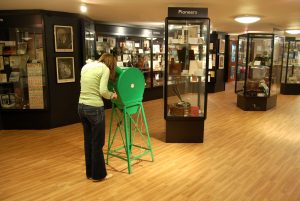The heritage sector is incredibly dynamic. Throughout the South West, heritage organisations and academic institutions are continually developing research and projects to maintain, preserve and uncover local and national heritage.
Freelancer and museum professional Anna Bryant manages, develops, and delivers heritage projects with a goal of helping heritage bodies reach and engage with new and existing audiences more effectively. This involves working with partnerships, audiences, and storytelling for museums, heritage sites and sector support organisations in the South West and nationally. With over 20 years of experience in the sector, Anna tells us about her experience as a freelancer and the opportunities that arise from freelance working.
After undertaking a BA in History and an MA in Museum Studies from the University of Leicester, Anna began her career in local history in London before moving to Wales to set up the Museum of Cardiff. Since then, she has run a partnership of all museums in Bath and, from 2016 to 2018, was Chair of the South West Fed (SWFed). She is an Associate of the Museums Association.
Anna describes her role as a museums’ consultant as running your own business: “not only do you need to keep up to date with current trends and networking, but also pitching for work — writing proposals as well as budgeting, marketing, and doing your tax return!”
An average work day for Anna currently involves sitting at her desk: “a day might involve planning a project out, preparing certain elements such as surveys and having a Zoom meeting to discuss an element of the work or writing a report.” However, as things are opening up, Anna will soon be able to return to museum site visits, in order to get to know a project better, meet people and support the research.
For Anna, the main benefits of freelance work are that the work is varied and that you’re in control of your schedule: “you choose when you work and what hours or days. I have school children at home so choose not to work in the summer holidays, for example. It also can be fun to see a project through to completion and have the satisfaction of wrapping it up.”
However, there are some challenges to this format of working. Anna tells us that “you have to be able to put yourself ‘out there’ and accept rejection as well as success! Working by yourself can be a challenge in terms of bouncing ideas around or time management, but that can be mitigated by working with project teams at the museums or organisations or having good freelancer networks to discuss challenges with.”
Anna says that she has always enjoyed working in the sector because it provides a very varied working life: “I enjoy its breadth from creativity to research, and particularly the satisfaction of working with or for audiences and engaging them with the stories museums can tell, which is opening up further all the time.” Anna has worked in partnership across all of her museum roles — both across museums, but also with community partners. She says that: “It’s a fantastic way to work, bringing new opportunities to all partners involved and opening up new ways of collaborating to enable a better visitor experience. It’s not always easy, though, and requires time and patience to ensure that all parties get what they need from the process.”
Anna has worked as a University of Exeter consultant, doing research into ticketing and membership at the Bishop’s Palace in Wells. She particularly enjoyed doing a focus group with members because it was: “a great way to challenge preconceptions about what research might throw up!”
To find out more about working in museum freelance, see: https://www.museumfreelance.org/.

